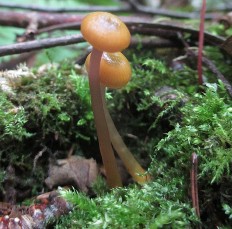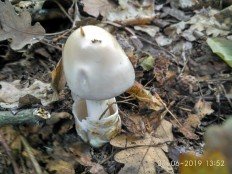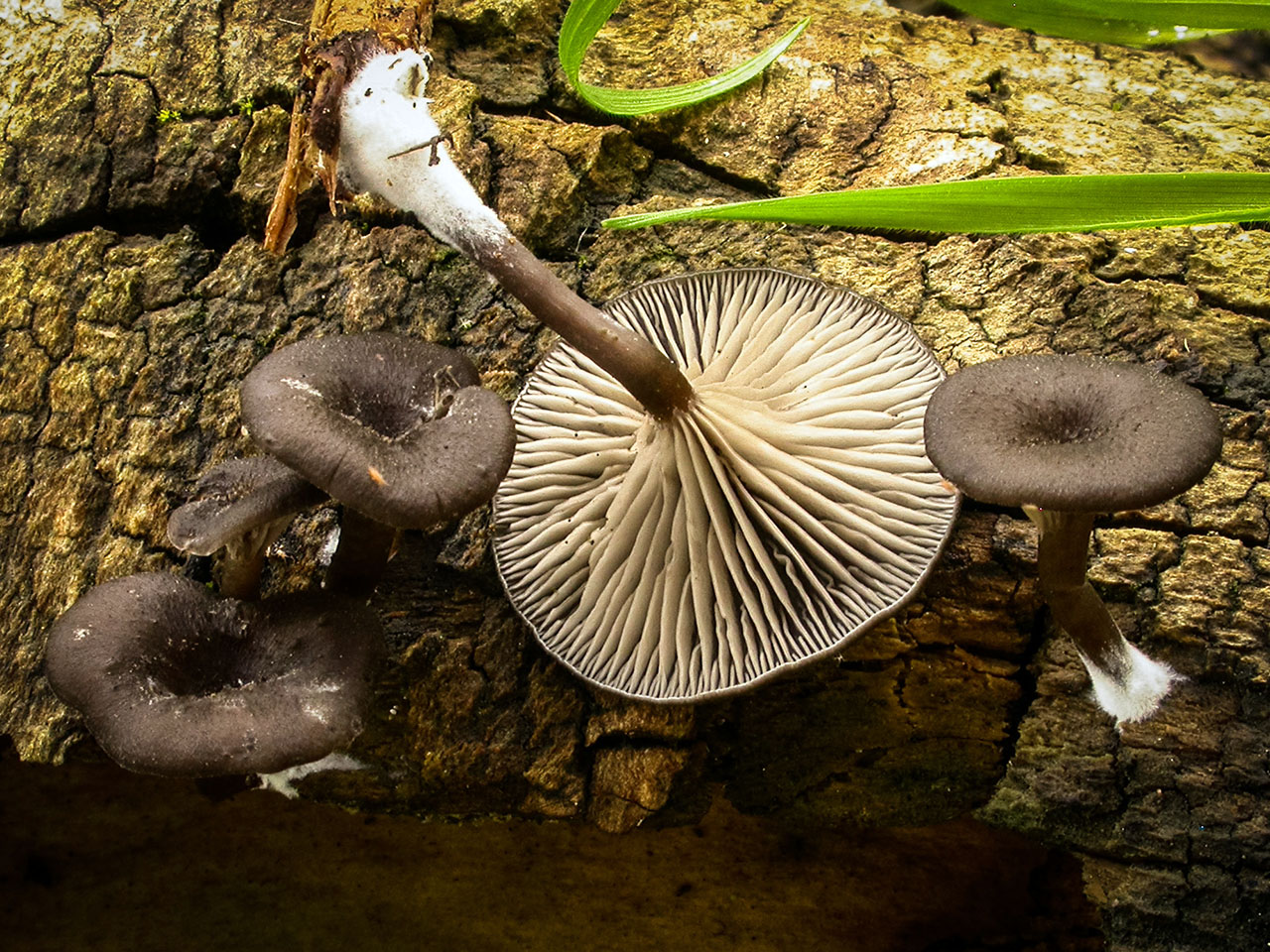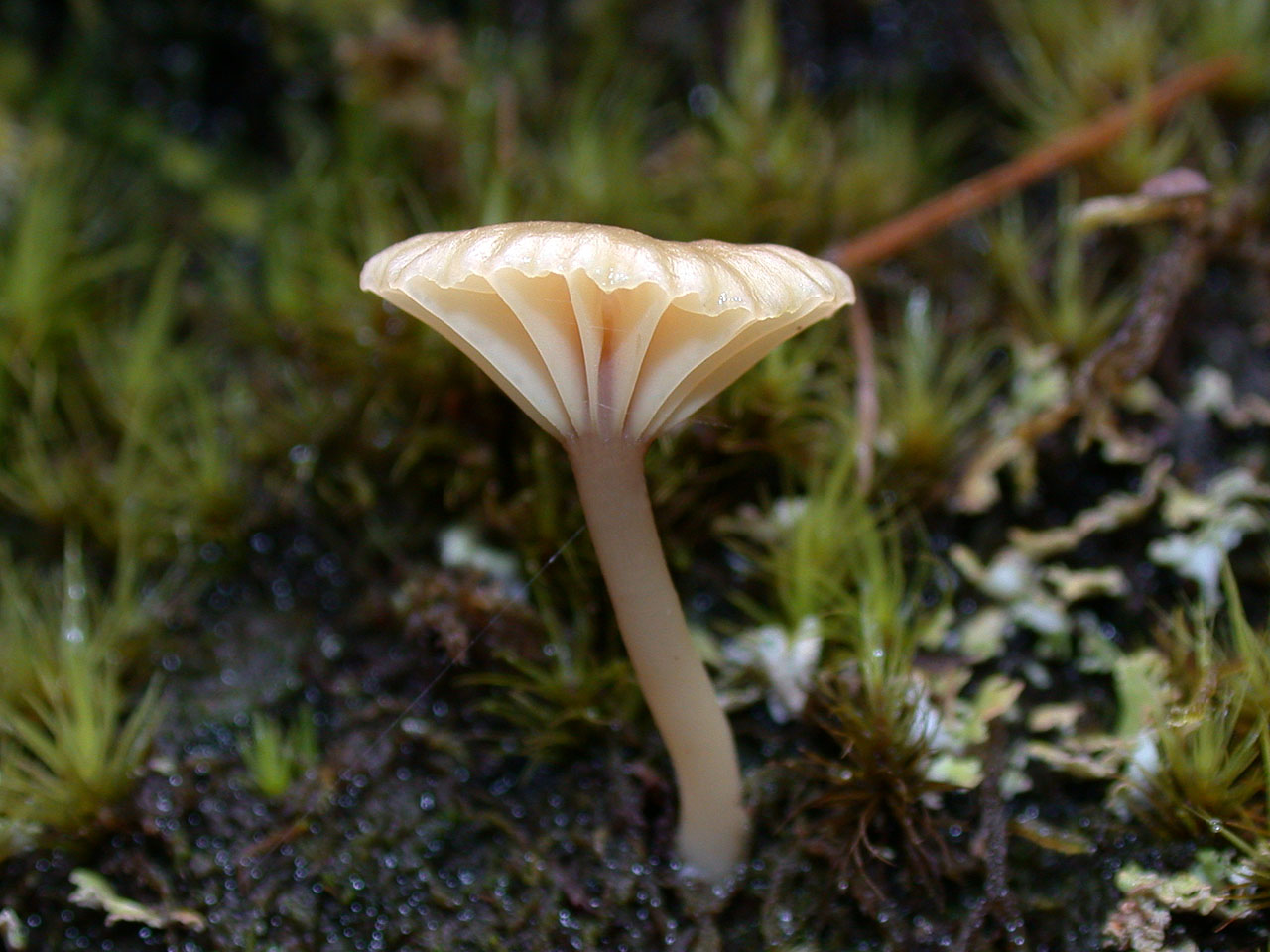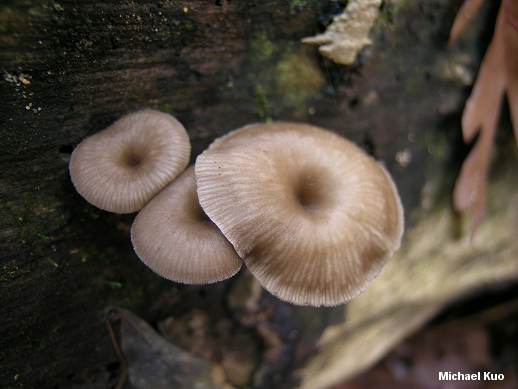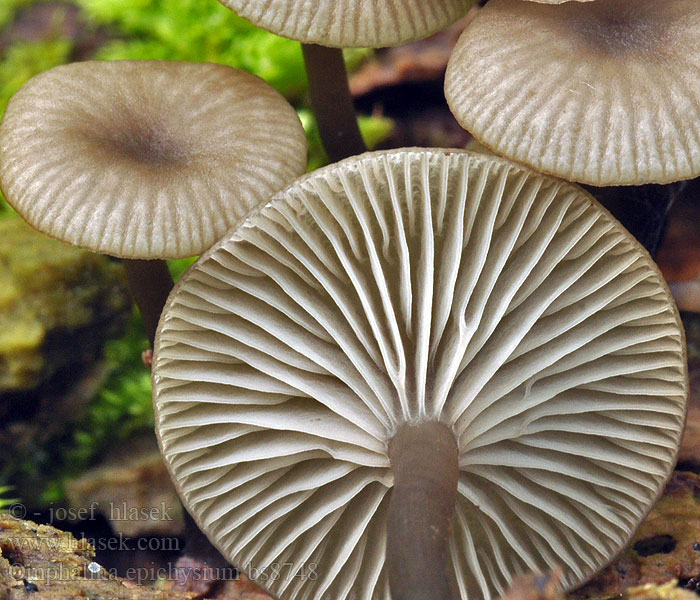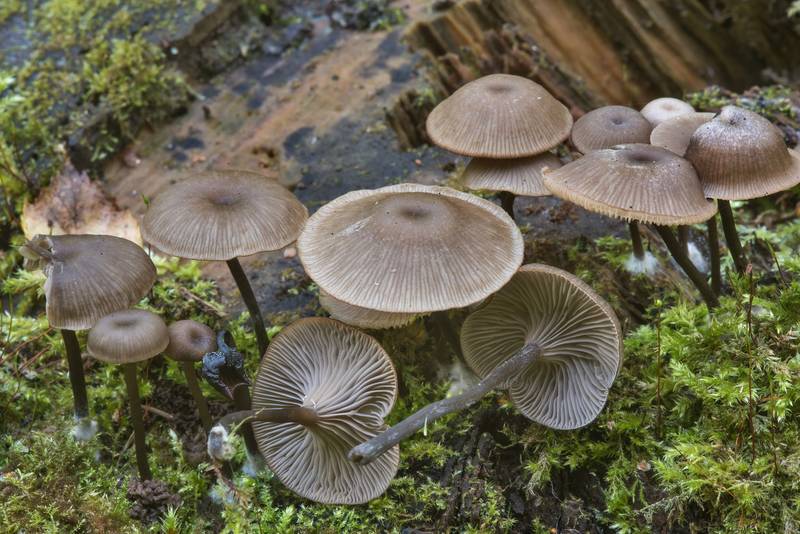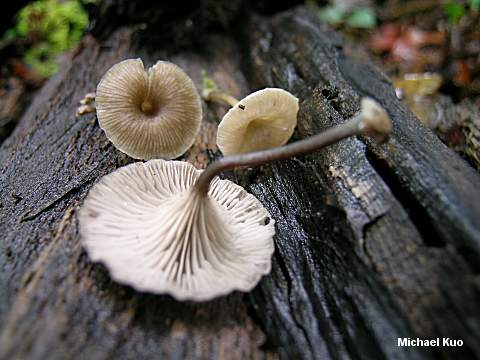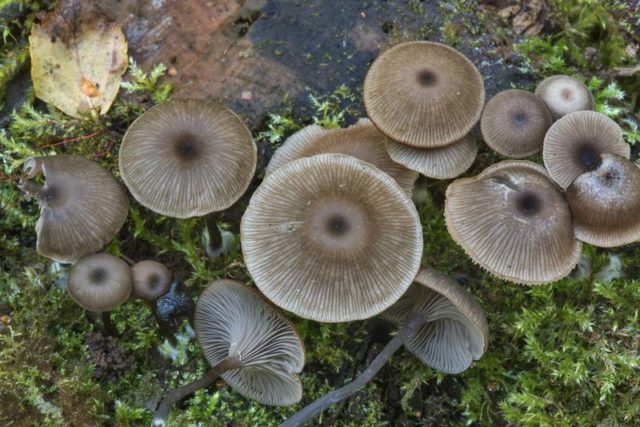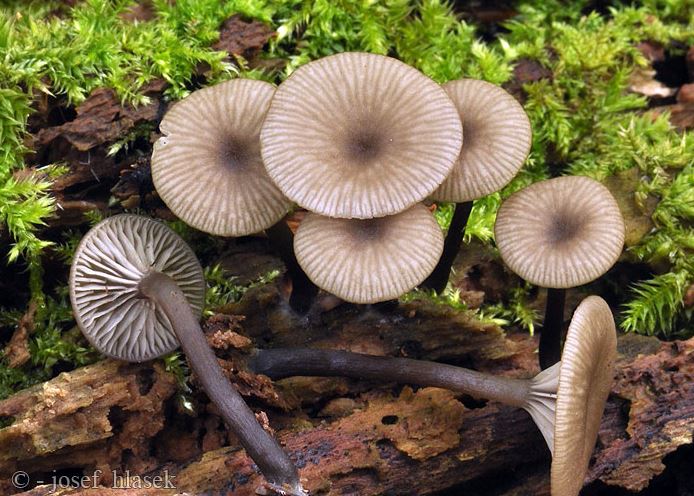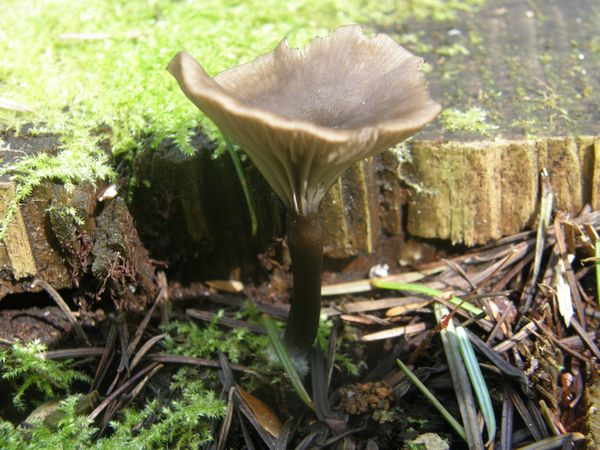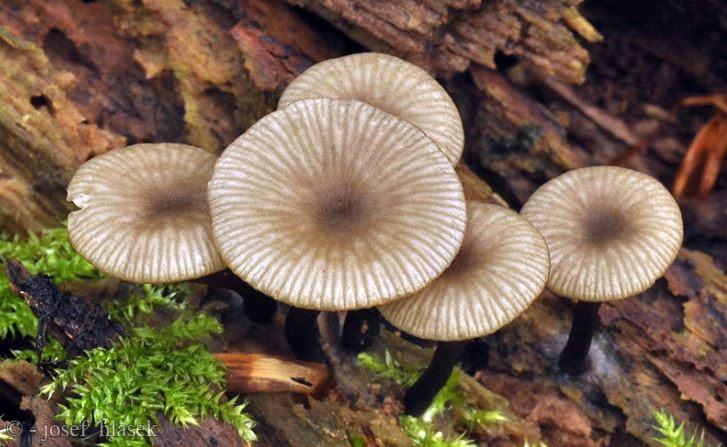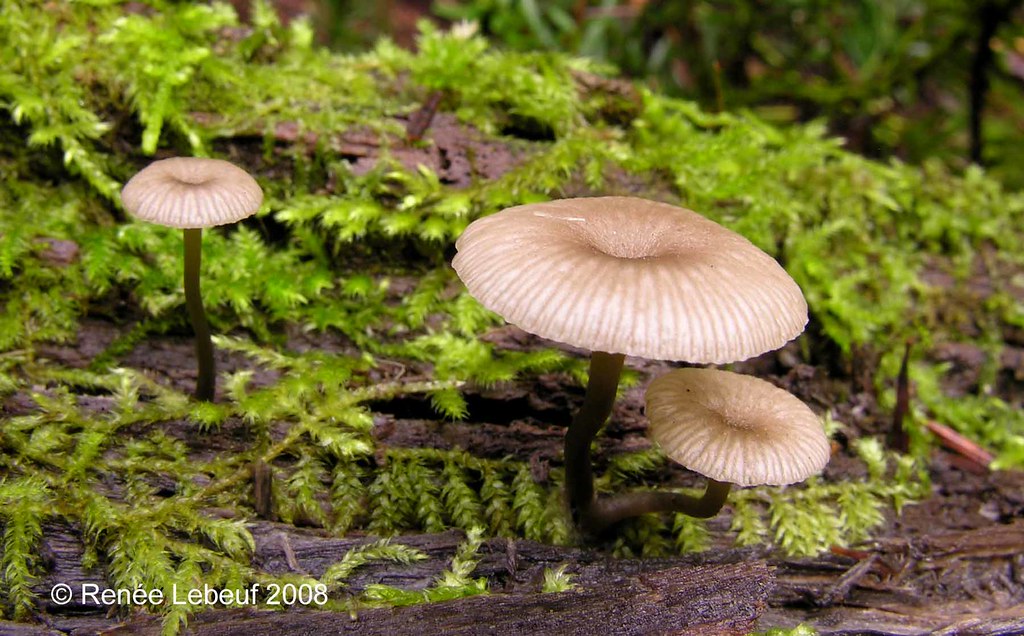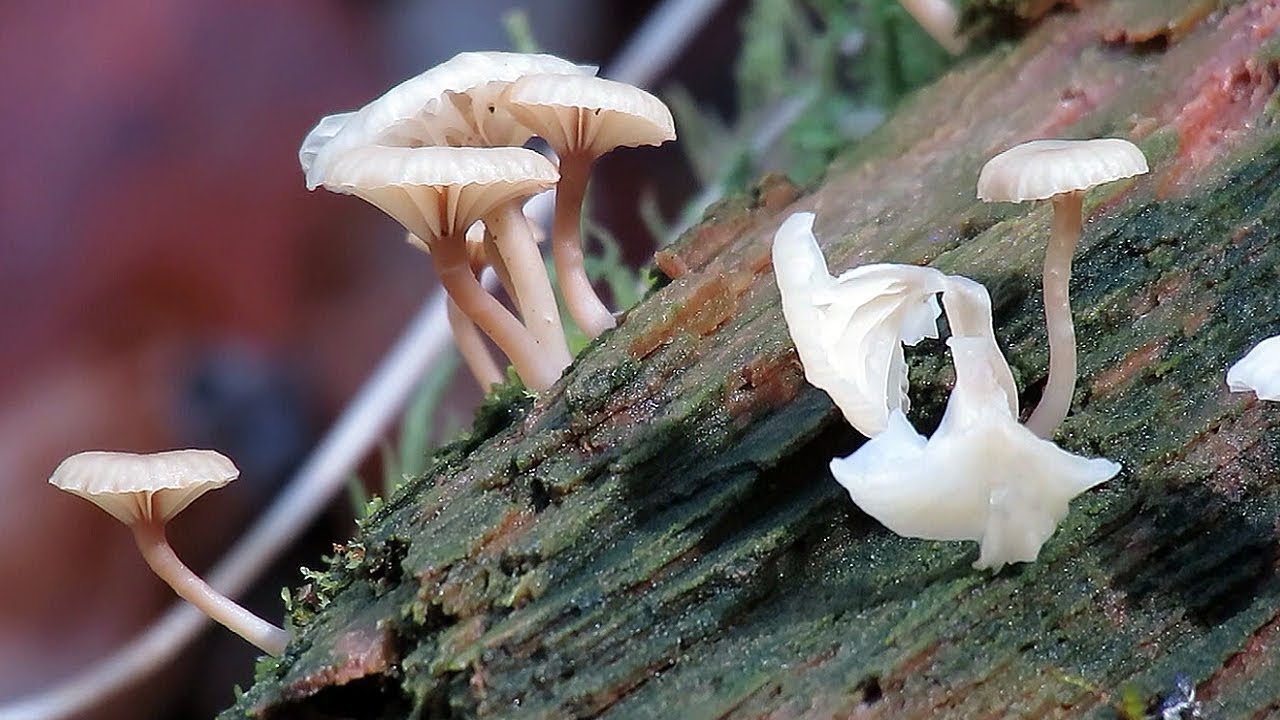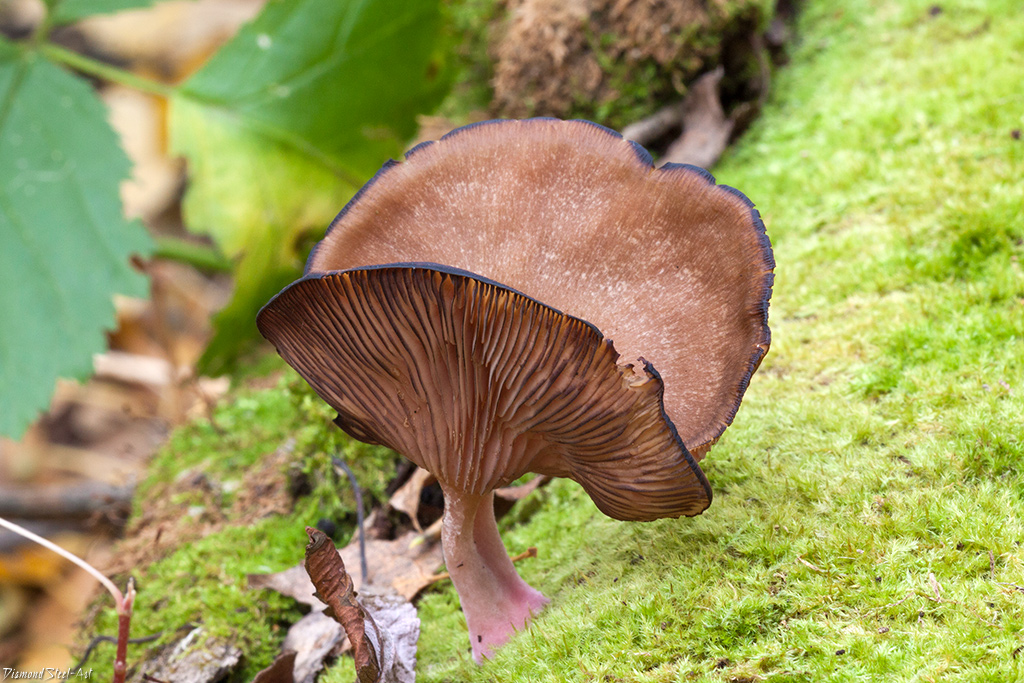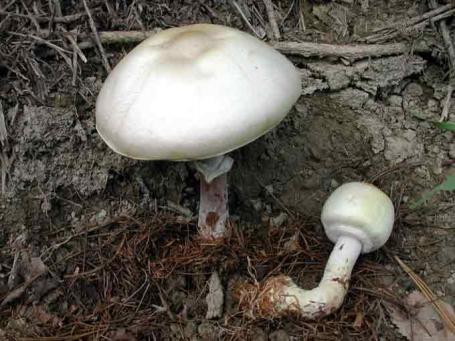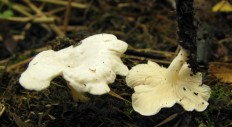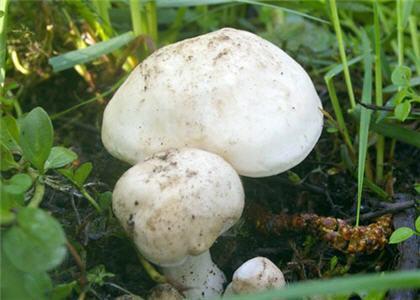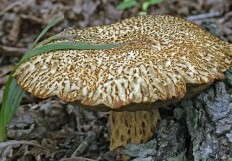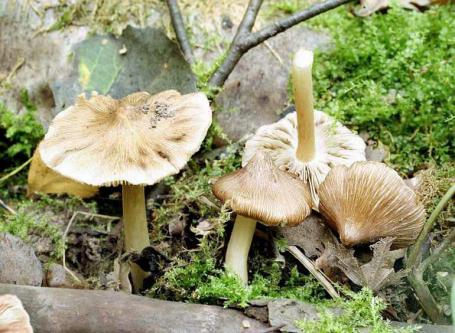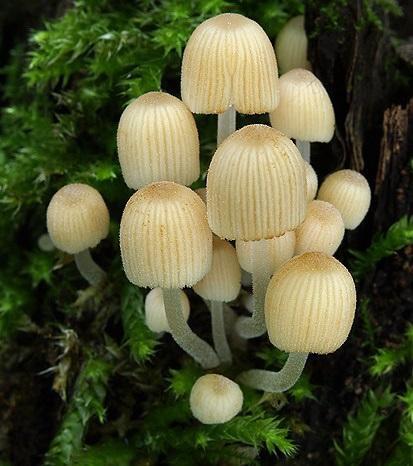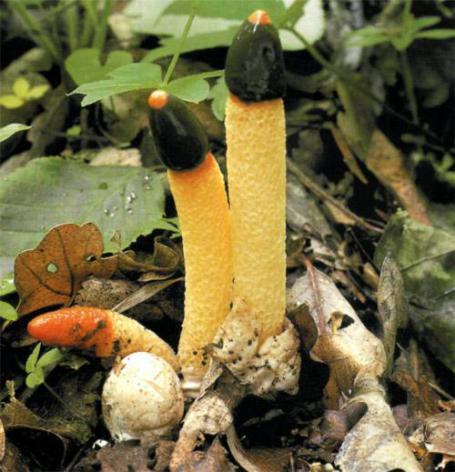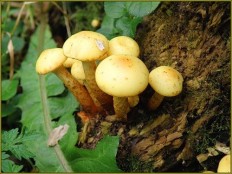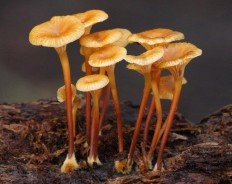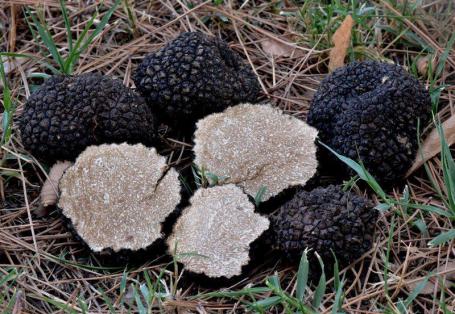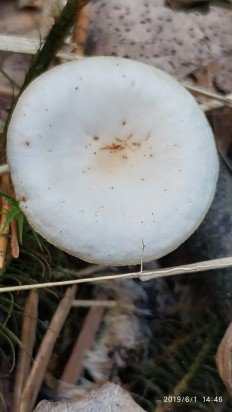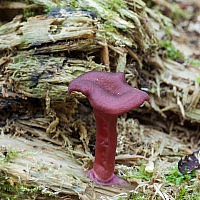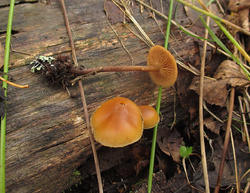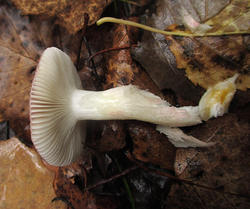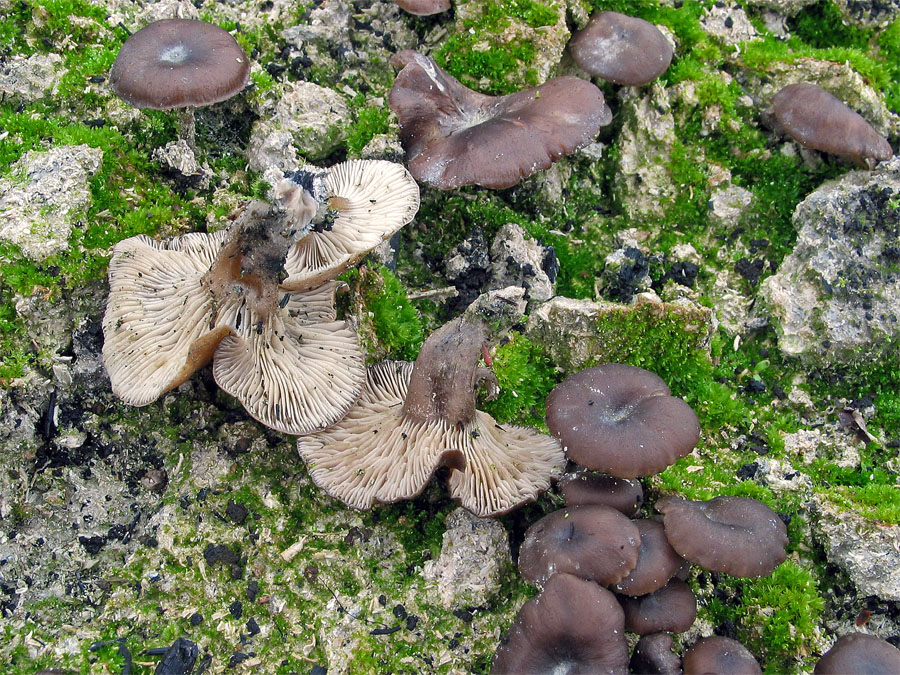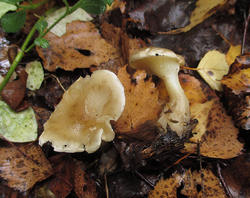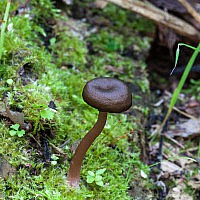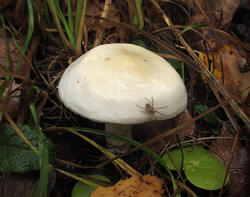Omphalina cinder (myxomphaly cinder): photo and description
| Name: | Omphalina cinder |
| Latin name: | Omphalina maura |
| Type of: | Inedible |
| Synonyms: | Fayodia charcoal, Fayodia maura), Myxomphalia cinder, Myxomphalia maura), Omphalia maura |
Omphalina cinder-representative of the Tricholomykh family. The Latin name is omphalina maura. This species has several synonyms: coal fayodia and cinder mixomphaly. All these names in one way or another indicate the unusual place of growth of this specimen.
Description of omphaline cinder
This species prefers mineral-rich, moist soil or burnt areas
The fruit body of the cinder omphaline is rather peculiar - due to its dark color. The pulp is thin, has a light powdery aroma, the taste is not pronounced.
Description of the hat
Grows singly or in groups in open areas
At the initial stage of development, the cap is convex in shape with tucked edges inward and a slightly squeezed center. Mature specimens are distinguished by a funnel-shaped, deeply depressed cap with uneven and wavy edges. Its size reaches a diameter of about 5 cm. The surface of the omphaline cinder cap is hygrophane, radially striped, smooth and dry, becomes sticky during the rainy season, and in drying specimens - shiny, grayish tone.
The peel from the cap of the cinder omphaline is removed quite easily. The cap is thin fleshy, its color varies from olive brown to dark brown shades. Under the cap there are frequent plates running down to the leg. Painted in white or beige shades, less often in yellowish. The spores are elliptical, smooth and transparent.
Leg description
Omphalina grows throughout the summer and in the first half of autumn.
The leg of the omphaline cinder is cylindrical, hollow, reaches no more than 4 cm in length, and up to 2.5 mm in diameter. As a rule, its color coincides with the color of the cap, but at the base it can be darker by several tones. The surface is longitudinally ribbed or smooth.
Where and how it grows
A favorable time for Omphalina cinder is the period from June to September. It prefers to grow on the territory of coniferous forests, and also quite often occurs in open areas, for example, in gardens or meadows, as well as in the midst of old fireplaces. Carries out fruiting one at a time or in small groups... Quite widespread in Russia, as well as in Western Europe and North Africa.
Is the mushroom edible or not
This species belongs to the category of inedible mushrooms. Despite the fact that omphaline cinder contains no toxic substances, it is not suitable for food.
Doubles and their differences
This species has no poisonous counterparts.
Omphalina cinder in appearance is similar to some gifts of the forest:
- Omphalina goblet - belongs to the group of inedible mushrooms. The twin's cap is funnel-shaped with a depressed central part, painted in light brown or dark brown shades. The surface is striped, smooth to the touch. The stem is thin, grayish-brown in color, the length of which is about 2 cm, and the thickness is no more than 3 mm in diameter. As a rule, it grows on deciduous and coniferous trees, which is the main difference from cinder omphaline.
- Omphalina Hudson is an inedible gift of the forest. Initially, the cap is convex in shape with edges tucked inward, as it grows, it becomes funnel-shaped, about 5 cm in diameter.It is painted in brown shades, fades in dry weather and acquires lighter colors. It does not have a pronounced smell and taste. Stem is hollow, almost even, slightly pubescent at the base. A distinctive feature of the cinder omphaline is the location of the mushrooms. So, the twin prefers to be located singly or in small groups among sphagnum or green mosses.
- Cinder scale - grows from May to October in coniferous forests on old fireplaces. At the initial stage, the cap is convex, after a while it is spread out with a small tubercle in the center. You can distinguish a double by the color of the fruiting body. So, the cap of cinder flakes is painted in yellow-ocher or reddish-brown shades. The leg is the same color as the cap, but at the base it may be a couple of tones darker. Light scales are located along its entire length, which form a zigzag pattern. Due to its hard pulp, it is not suitable for food.
Conclusion
Omphalina cinder is a rather interesting specimen, which differs from its relatives in the dark color of fruit chalk. But this gift of the forest does not carry any nutritional value, and therefore it is not recommended to collect. Despite the fact that no toxic substances were detected in the omphaline cinder, due to the thin pulp and small size of the fruit bodies, this specimen is not suitable for food.
Chromosera cyanophylla (Chromosera cyanophylla)
Synonyms:
- Omphalina cyanophylla
- Omphalia cyanophylla
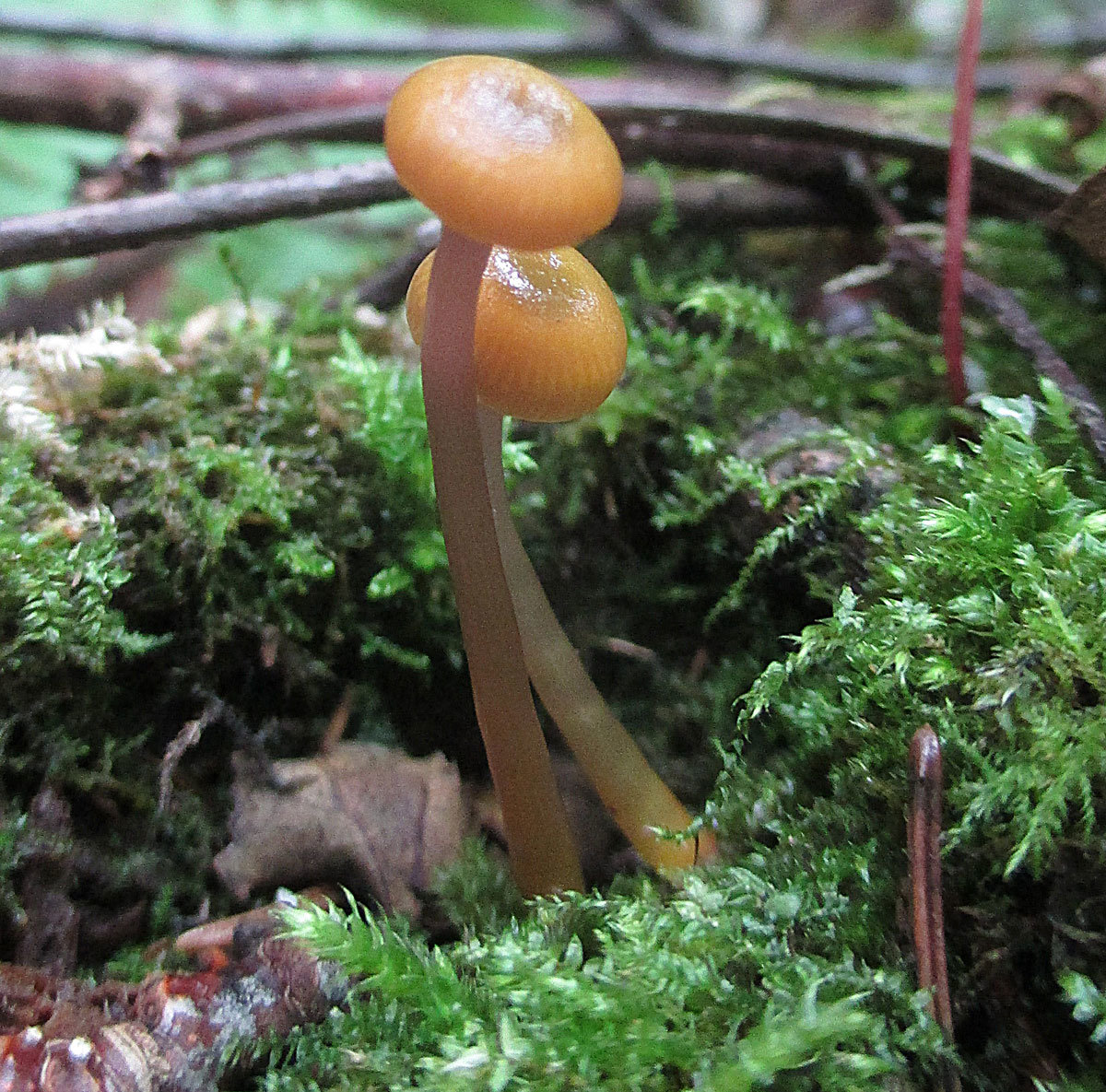
Description
Hat with a diameter of 1-3 cm; first hemispherical with a flattened or slightly depressed center, with a tucked edge, then truncated-conical with a raised or upwardly curved edge; smooth, sticky, slimy in wet weather; striatal from the edge of the cap and up to ¾ radius; in older specimens, it may be hygrophilous. Initial color is dull yellow-orange, ocher-orange, olive green with orange hues, lemon yellow; then dull yellow-olive with green, orange and brown tints, grayish-olive by old age. There is no private veil.
The flesh is thin, the shades of the colors of the cap, the taste and smell are not expressed.
The plates are thick, sparse, descending; there are up to 2 groups of shortened plate sizes. The color is first fawn pink-violet, then blue-violet, and, towards old age, gray-violet.
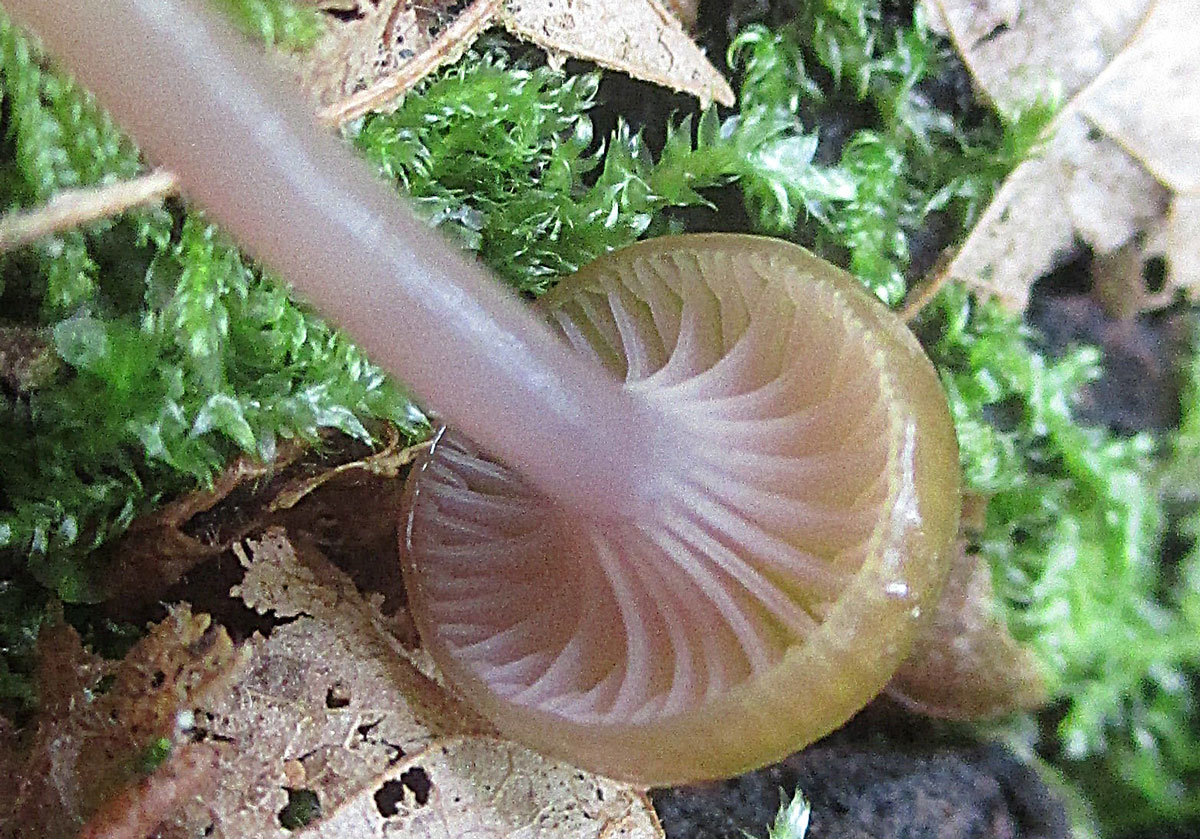
White spore powder. Spores are elongated, of various shapes, 7.2-8x3.6-4.4 μm, Q = 1.6 ... 2.5, Qav = 2.0, Me = 7.7 × 3.9, thin-walled, smooth, hyaline in water and KOH, non-amyloid, not cyanophilic, with pronounced apiculus.

The leg is 2-3.5 cm high, 1.5-3 mm in diameter, cylindrical, often with an extension at the base, often curved, slimy, sticky and shiny in high humidity, sticky, dirty-cartilaginous in dry weather. The colors of the leg are varied, with violet-brownish, yellow-violet, yellow-green, olive shades; dirty fawn in young or old mushrooms; often pronounced bright blue-violet at the base.

Habitat
It grows in the first half of summer (perhaps not only, these are my personal observations, according to which it grows together with Mycena viridimarginata both in time and in the substrate), on rotten coniferous wood: spruce, fir, according to the literature, less often, and pines.
Similar species
There are no similar species, due to the very peculiar color of the fruit chalk. From the first, superficial, glance, some faded specimens can be mistaken for Roridomyces roridus, but, from a second glance, this version is swept away immediately.
Edibility
Edible is unknown.
References. Holec, Jan & Kříž, Martin & Beran, Miroslav & Kolarik, Miroslav. Chromosera cyanophylla (Basidiomycota, Agaricales) - a rare fungus of Central European old-growth forests and its habitat preferences in Europe. Nova Hedwigia Vol. 100 (2015) Issue 1-2, 189-204
Myxomphaly cinder
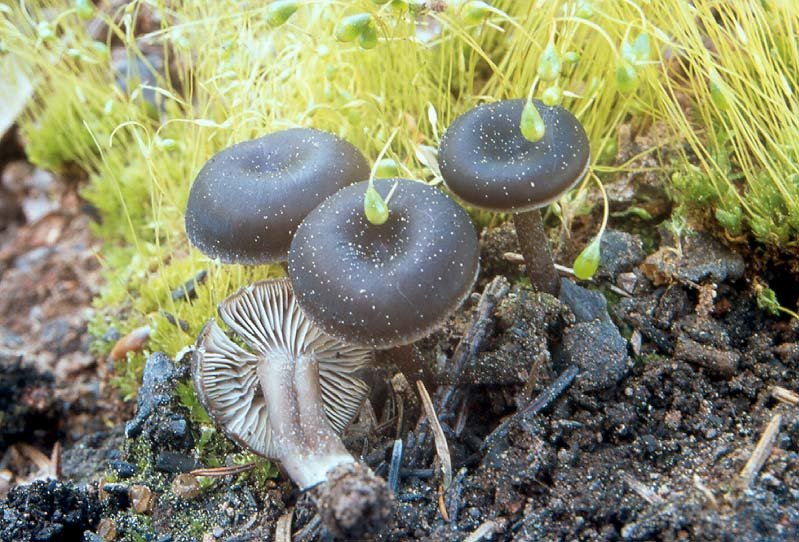
Myxomphalia cinder (Myxomphalia maura)
- Omphalina cinder
- Omphalina maura
- Fayodiya coal
- Fayodia maura
- Omphalia maura
Myxomphalia maura is a mushroom of the Tricholomov family.
External description
The described mushroom has a rather noticeable appearance, is painted in a dark color, grows in fires, since it belongs to the number of carbophilic plants. This species got its name precisely for the place of growth. The diameter of its cap is 2-5 cm; already in young mushrooms, it has a depression on its surface. The caps of myxomphaly cinder are thin-fleshy, have an edge lowered downward. Their color ranges from olive brown to dark brown. In drying mushrooms, the surface of the caps becomes shiny, silvery-gray.
The hymenophore of the fungus is represented by white plates, often located and descending to the leg. The mushroom stalk is characterized by internal emptiness, cartilage, gray-black color, 2 to 4 cm long, and 1.5 to 2.5 mm in diameter. The mushroom pulp is characterized by a mealy smell.Spore powder is represented by the smallest particles with a size of 5-6.5 * 3.5-4.5 microns, which have no color, but are characterized by an elliptical shape and a smooth surface.
Season and habitat
Cinder mixomphalia grows in open areas, mainly in coniferous forests. They are found singly or in small groups. She can often be seen in the middle of old fireplaces. The period of active fruiting of the species falls on summer and autumn. Brown spores of the fungus are located on the inner surface of the cap.
Similar types and differences from them
Cinder myxomphaly bear little resemblance to the inedible black-brown omphaline (Omphalina oniscus). True, in this species, the hymenophore plates are gray, the mushroom grows on peat bogs, and is characterized by a cap with a ribbed edge.
Mushroom photo Myxomphaly cinder from questions in recognition:
Omphalina crippled
Omphalina mutila ((Fr.) P. D. Orton (Clitocybe josserandii (Singer) Singer))
Family Ordovkovy - Tricholomataceae

Habitats and biology
Inhabits poor substrates: on moist acidic soil or peat in swampy habitats, as well as in sandy wastelands (among rushes, thorns, heather, etc.). In the region, it was found on peat, among the lightning in the Lupishkinsky bog, as well as on the sandy cliff of the Oka bank near Chekalin, among the rushes and grasses. Fruiting bodies are formed in groups in July-September.
Limiting factors and threats
A rarity in an area of suitable habitat. Drainage of bogs or changes in their hydrological or hydrochemical regime, as well as trampling, driving of livestock, burning of grass and peat fires pose a threat.
Description of the species
The fruiting body is small, consists of a stem and a cap with a lamellar hymenophore. The cap is 0.8-4 cm in diameter, flat, with an irregular edge, then concave (up to funnel-shaped), with an unevenly curved edge. The damp cap is whitish, slightly translucent; dry - pure white, dull, like a white eggshell. The plates are rather rare, often forked, widely accreted or descending, white. Stem 0.5-1 x 0.3-0.6 cm, flat or narrowed downwards, often eccentric, white or pale cream, thin-clotted or almost smooth. The pulp is thin, white, without any special smell. The taste is bland or bitter; edibility unknown. Spore powder is white; spores are drop-shaped, 7.5-10 x 5-6 microns.
Spreading
The European species, better known in the Atlantic countries, is rare in most of them. There is little information about its distribution in Russia: except for the Tula region, where the species was found in the Kimovsky and Suvorovsky regions, it is known from the Samara region and the Northwestern Caucasus.
Necessary security measures
Compliance with the regime of protection of the natural monument in terms of restricting visits to the habitat of the species, as well as compliance with fire safety standards. Monitoring the status of known populations. Organization of the projected reserve "Lupishkinskoye swamp". Search for new locations of the species in suitable habitats and, if necessary, organize their protection.
Ecology and distribution
Mostly saprophyte grows on the roots of bamboo, sometimes palm trees. In China, it is distributed in the south in the Yangtze River basin, especially in the provinces of Jiangsu, Zhejiang, Hunan, Hubei, Sichuan, Yunnan, Guizhou, Guangxi, Guangdong, Fujia, in the north - in the provinces of Henan, Shaanxi and Gansu. Omphalia loves a warm climate, prefers loose, relatively waterless soil. Along with the wild one, there is the “domesticated” Leiwan. For its cultivation in spring or autumn, a pit of 3x2x2 m is prepared, which is filled with humus. Leiwan is ground into powder and poured into a pit, a layer of soil is applied on top and its surface is "corrugated" to create a favorable water regime for the fungus.
During the growing period, care should be taken to avoid excessive moisture. Leiwan grown in this way is large in size and of good quality.
Bibliography
- Dingyonghai, Gong Juan, Yu Ming Kun. Research of methods of purification and physicochemical properties of agglutinin Leiwan // System of mushrooms. 2000.19 (2): 278-282.
- Lin Shuqian. Deep cultivation of Leiwan mushroom // Production of medicinal mushrooms in China. Beijing: Chinese Agriculture, 2000.
- Sevan Zhong, Yu Yuqin. State Report on Chinese Medicines, Scientific Research Institute of Chinese Medicine. Beijing: People's Sanitation Publishing House, 1996.
- Zhao Guang Hong, Xu Zhi Biao, Guo Mao Di et al. Changes in the histology of cysticercoid under the influence of Leiwan protease // Medical Press. 1998, 21 (1): 65-67.
- Cheng Gui Fang, Ling Yingyuan, Liu Dapei et al. Antiflogistic efficacy of Leiwan polysaccharide hydrolyzate // Bulletin of the Chinese Academy of Medical Sciences. 1990.12 (1): 60.
- Yan Mingyu, Hehui Min, Zhu Jin Chang, et al. Antidynatronic efficacy of Leiwan against U14 ascites cancer in mice // Bulletin of the Wenzhou Academy of Medical Sciences. 1993,23 (1): 10-13.
Lichenomphalia umbellifera

Current title
| Index Fungorum | Lichenomphalia umbellifera (L.) Redhead, Lutzoni, Moncalvo & Vilgalys | |
| MycoBank | Lichenomphalia umbellifera (Linnaeus) Redhead, Lutzoni, Moncalvo & Vilgalys |
Systematic position
Etymology of the species epithet
Umbelliferus, a, um, having an umbrella, with an umbrella. From umbella, ae umbrella + fero wear, carry.
Synonyms
- Agaricus umbelliferus L., Sp. pl. 2: 1175 (1753)
- Merulius umbelliferus (L.) With., Arr. Brit. pl., Edn 3 (London) 4: 147 (1796)
- Omphalia umbellifera (L.) P. Kumm., Führ. Pilzk. (Zerbst): 107 (1871)
- Omphalina umbellifera (L.) Quél., Enchir. fung. (Paris): 44 (1886)
- Clitocybe umbellifera (L.) H.E. Bigelow, Can. J. Bot. 37: 773 (1959)
- Botrydina botryoides (L.) Redhead & Kuyper, Arctic Alpine Mycology, II (New York): 333 (1987)
- Botrydina vulgaris Bréb., Mém. Soc. Acad. Agric. Industr. Instruct. Arrond. Falaise 1839: 36 (1839)
- Omphalia ericetorum (Pers.) S. Lundell, Fungi Exsiccati Suecici: no. 1753 (1949)
- Omphalina ericetorum (Pers.) M. Lange, Meddr Grønland, Biosc. 147 (no. 11): 25 (1955)
- Gerronema ericetorum (Pers.) Singer, Beih. Sydowia 7:14 (1973)
- Omphalia chrysoleuca (Pers.) P. Karst., Bidr. Känn. Finl. Nat. Folk 32: 125 (1879)
- Omphalina chrysoleuca (Pers.) Quél., Enchir. fung. (Paris): 42 (1886)
- Omphalina myochroa (Fr.) Quél., Enchir. fung. (Paris): 44 (1886)
- Omphalia myochroa (Fr.) Sacc., Syll. fung. (Abellini) 5: 322 (1887)
- Omphalia griseolilacina Steinheim, (1888)
Other names: Omphalina wasteland, Omphalina is umbrella.
Umbelliferous lichenomphaly is a lichen or lichenized fungus, that is, it is a symbiosis of a fungus (mycobiont) and green algae (phycobiont). But, unlike the lichens we are used to, lichenomphaly bears fruit with "ordinary" cap-stem fruiting bodies, and the lichenized part is located nearby, on the same substrate, in the form of a thallus (thallus), inside which there is a phycobiont - unicellular algae of the genus Coccomyxa. Thallus in representatives of the genus Lichenomphalia are divided into two types: Botrydina - consists of dark green gelatinous, loose balls 0.1 - 0.3 (1.0) mm in diameter, formed by a group of green algae, partially penetrated by hyphae and surrounded by a thin layer of hyphae; Coriscium - consists of rounded or finely lobed thin light green scales 2 - 3 (5) mm in diameter, with a light, curled up edge, tightly adhered to the substrate.
The names Botrydina and Coriscium survived from the names of the originally described primitive lichens (Botrydina vulgaris Bréb. 1839 and Coriscium viride (Ach.) Vain. 1890), when it was not yet known that this was one organism with a nearby growing fungus.
Habit
Fruit body: Cap and stem (agaricoid)
Hymenophore: Lamellar (including folded or with rudimentary plates)
Tall
The Botrydina-type thallus, covering the substrate with a dense carpet, consists of globular dark green granules. The hyphae enveloping the algae are (2.5) 3 - 4 (6) µm in diameter, the walls of the hyphae are mainly 0.5 - 1 µm thick.
Hat
The cap is 4 - 20 mm in diameter, initially convex, almost flat, when ripe it is concave in the central part, funnel-shaped, striped by ¾ of the radius. The edge is serrated, like a gear, often torn. The surface is smooth, hygrophane, yellow-brown, light ocher, with a dark brown center, eventually fades to pale yellow, beige or almost white.
The plates are deeply descending, sometimes bifurcating and with anastomoses, pale yellow.
Leg
Stem 10 - 25 mm long, 1 - 2 (3) mm in diameter, central, cylindrical or slightly tapering towards the base. The surface is smooth, with white pubescence at the base, yellow-brown, brown in the upper part, brightens downward.
Pulp
The pulp is the same color with the surface, the smell and taste are not expressed.
Microscopy
Spore powder is white.
Spores 7 - 10.5 (11) × (4.5) 6 - 8 μm, Q = 1.2 - 1.5, almost spherical, ellipsoidal, smooth, thin-walled, transparent.
Basidia 45 - 60 × 9 - 13 μm, 2-, 4-spore.
Cystyds are absent.
Pileipellis consists of parallel hyphae 2.5 - 5 µm in diameter, sometimes with brown inlay, septa without buckles.
Ecology and distribution
- Substance: Woody plants (living trees, bark and dead wood)
- Substrate: Soil, litter
It grows singly and in groups among mosses on old valezha, humus soil, sometimes on mossy foundations of tree trunks and roots in more or less humid conditions.



